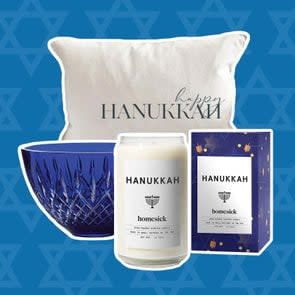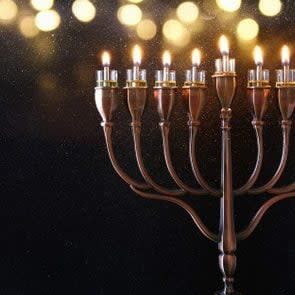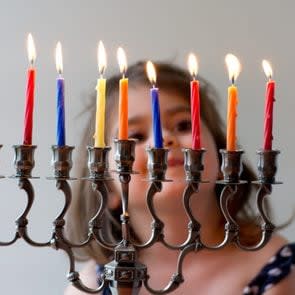What Is Hanukkah and Why Do We Celebrate It?
Because Hanukkah and Christmas fall around the same time of year, people often wonder if Hanukkah is a Jewish version of Christmas. At least religiously speaking, it is not. Whereas Christmas marks the birth of Jesus, Hanukkah, which was celebrated for centuries before Jesus was born, commemorates something entirely different. So what is Hanukkah exactly? Read on to learn everything you need to know about the holiday, from its history to Hanukkah traditions to the number of candles on a menorah. You may even get some inspiration for this year’s Hanukkah gifts.
What is Hanukkah?
Hanukkah commemorates the victory in 164 B.C. of a group of Jewish people (the Maccabees) over the Syrian Greeks, who had been occupying the Land of Israel since before 167 B.C. Not only had the Greeks destroyed the Jewish Temple in Jerusalem, but they also banned the practice of Judaism entirely. After a three-year fight, the Maccabees liberated the Temple—and won the Jewish people the right to practice their religion.
Scholars believe the first Hanukkah celebration was actually a belated celebration of Sukkot, a weeklong holiday that typically takes place in autumn. When the Maccabees prevailed over the Syrian Greeks, they wanted to celebrate important holidays they’d missed during the Maccabean Revolt. Despite the fact that it was early winter, they celebrated Sukkot as they rededicated the temple. (Sukkot was never again celebrated in the winter; it went back to being a fall holiday.)
The rededication of the temple involved turning on the lights, so to speak. Since electricity was a long, long, long way from being invented, people relied on oil lamps. At the time of the rededication, oil was in short supply, and there was just enough in the temple to provide light for a single day. But miraculously, the oil continued to burn for the entire time the Jewish people were celebrating Sukkot, a total of eight days, including the dedication. That’s why Hanukkah has always been celebrated for eight nights.
The Jewish people continued to celebrate the temple rededication annually, but it would take another 250 years before Hanukkah came to be known as the Festival of Lights, a term coined by the ancient Jewish historian Flavius Josephus. Some historians believe Josephus was referring not to a lighting of lamps but to enlightenment—as in a newly acquired freedom to worship. Either way, the notion stuck. In fact, many people associate Hanukkah more with the miracle of the oil than with the rededication of the temple.
When does Hanukkah start?
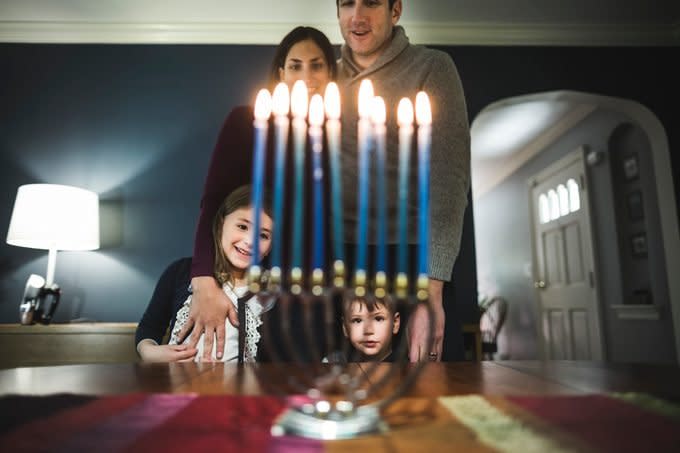
In 2021, Hanukkah begins at sundown on November 28 and finishes at sundown on December 6. If you’re wondering why Hanukkah falls on a different date every year, it actually doesn’t, according to the Hebrew calendar. The rededication took place on the 25th day of the month of Kislev in 164 B.C. Every year since then, the start of Hanukkah has been on 25 Kislev. But the Hebrew calendar is lunar, meaning it follows the moon, whereas most of the rest of the world uses a solar-based calendar, which follows the sun. Because the lunar and solar calendars don’t line up precisely, Hanukkah can fall any time from late November to late December.
How is Hanukkah celebrated?
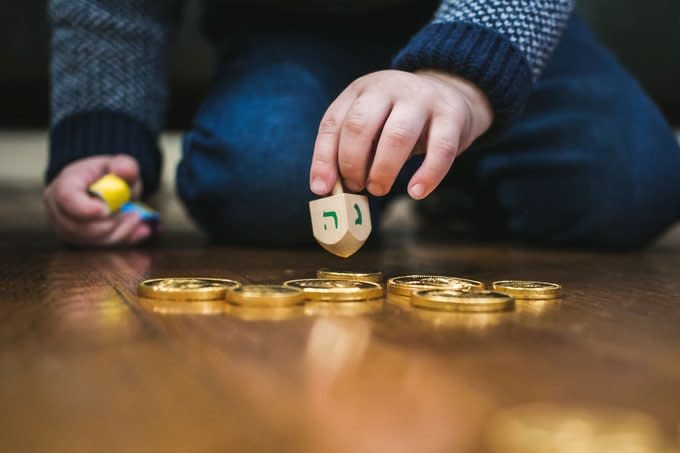
Hanukkah is celebrated by playing dreidel, singing celebratory songs, exchanging gifts, making delicious Hanukkah recipes that remind us of the oil that burned for eight days at the temple in Jerusalem (jelly doughnuts called sufganiyot, potato latkes), and lighting candles while chanting specified blessings.
The traditional Jewish menorah has seven branches for seven candles and is considered a symbol of the Jewish religion. That’s what the Jews used in the first Hanukkah celebration at the temple in Jerusalem. The menorah we now use on Hanukkah is called a hanukkiah and has nine candles—one representing the original vial of oil and eight representing the days the oil burned. It wasn’t part of Jewish practice until at least some time after Josephus first wrote about the Festival of Lights.
The hanukkiah is generally lit after sunset, but depending on your branch within the Jewish faith, you may wait until nightfall. On the first night, one candle is placed in the spot furthest to the right, and it’s lit by the shammash (the ninth candle), which is then placed in its designated place. Every night after that, a new candle is placed to the left of the previous candle from the night before, but the shamash lights them all, from left to right.
Playing with dreidels, or spinning tops, is a Hanukkah tradition for all ages. The custom dates back to the Greek-Syrian rule over the Holy Land. Since learning the Torah at the time was outlawed, Jewish kids would pretend to play with a dreidel when they were really studying.
Although packaged gifts are more popular today than they were in the past, gelt, or money, is the traditional gift of Hanukkah. Some people say that because of the rise in popularity of Christmas gifts, more Jewish people opt for gifts too.
Facts about Hanukkah
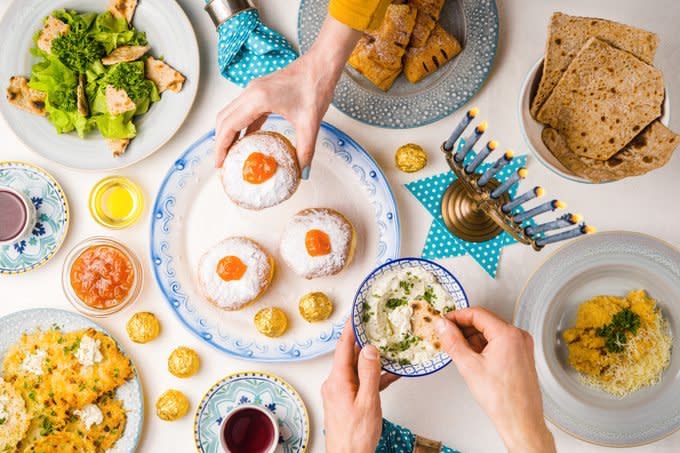
The word “Hanukkah” is Hebrew for “dedication,” which refers to the rededication of the temple after the Maccabees’ victory.
The traditional foods for Hanukkah are fried because they celebrate the miracle of oil that kept the menorah lit. Traditional foods include latkes, jelly doughnuts, and blintzes.
Although it’s customary to place the menorah in a window, this wasn’t always the tradition. In fact, in Mishnaic times, the menorah was placed on the left side of the door before it was forced indoors. Since the mezuzah is on the right side, placing the menorah on the left means you are surrounded by holiness.
The first and second Books of the Maccabees are part of the Septuagint, the Greek translation of the Hebrew Bible, which became the template for the Christian version of the Bible.
Jesus, having been born into a Jewish family more than a century after the events described in 1 Maccabees and 2 Maccabees, would have celebrated Hanukkah along with his fellow Jews in the first century A.D. Evidence of his having celebrated Hanukkah is in John 10:22-24, which refers to Jesus attending the Festival of Dedication in Jerusalem.
There isn’t really a correct way to spell Hanukkah—in English, that is. In Hebrew, it’s “חנוכה” but since Hanukkah is a Hebrew word, and Hebrew can’t be spelled with English letters, there is no standard English spelling. Instead, it is spelled phonetically, which is open to interpretation. For example, while Merriam-Webster prefers “Hanukkah,” it’s perfectly fine to spell it “Hanukah” or “Hannukkah” or “Chanukah” or “Chanuka” … you get the point.
Next, check out some of the best Hanukkah desserts you can make this year that will light up your tastebuds.
Sources:
My Jewish Learning: “Hanukkah 101”
History: “Hanukkah”
Chabad: “What Is a Dreidel (Sevivon)?”
Bible Gateway: “John 10:22–24”
The Best Hanukkah Decorations
Where to Celebrate the Festival of Lights
Festive Hanukkah Crafts for Kids
The post What Is Hanukkah and Why Do We Celebrate It? appeared first on Reader's Digest.
